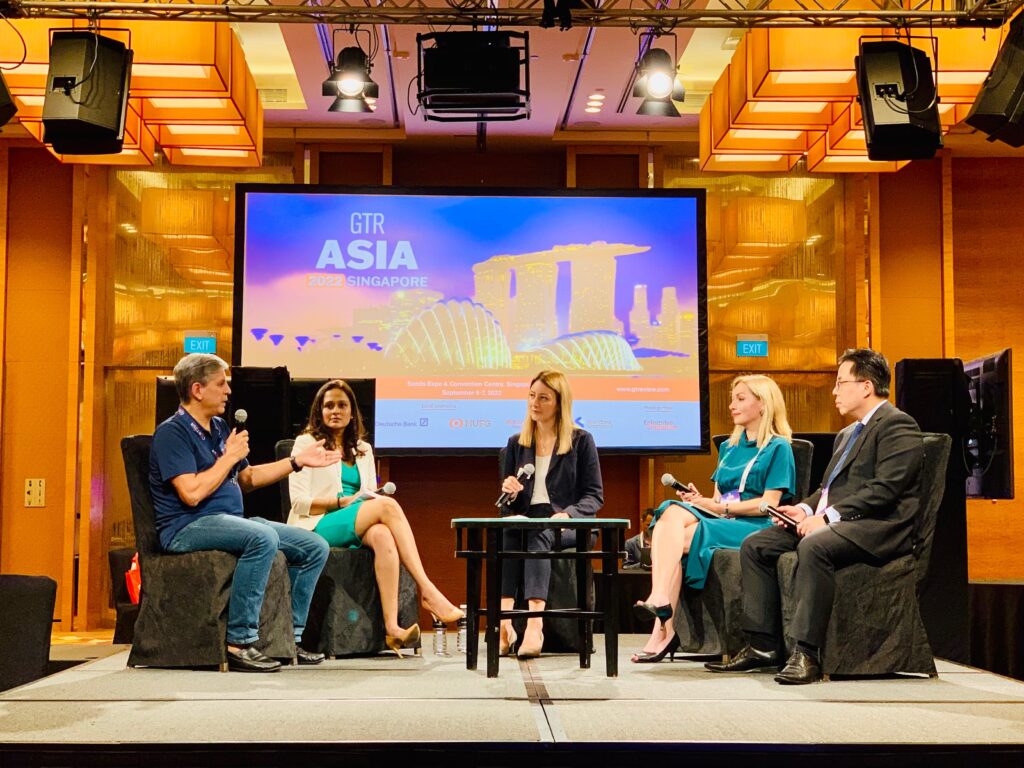When it comes to the digitisation of trade finance, the industry is often fixated on the momentum and when we’ll get to the finish line. While there are obstacles, there are also opportunities for both corporates and banks to get on board the digitisation bandwagon. Here is a summary of the views of industry insiders from a GTR Asia 2022 panel discussion in Singapore.

What are the obstacles?
The panellists agreed that these three obstacles are hindering the adoption of digitisation:
- Lack of standardisation
- Alignment and awareness of existing standards (like ICC-led standards, FIATA Bill of Lading, URDTT)
- The right type of interoperability between participants
Signs of progress on the standards front:
- Adoption of UNCITRAL Model Law on Electronic Transferable Records (MLETR)
- UCP rules adopted in 175 countries
Why collaboration is key
Contour’s CEO, Carl Wegner, emphasised that there is no single company that will solve the problems in trade, but the answer lies in consolidation and collaboration.
“Trade is very complicated. Trade finance is just one piece of trade. There’s shipping, container booking, bunker monitoring, all these different components of trade, and no one’s an expert on everything. If you can get there, there will be consolidation, and we see that consolidation happening already. There’s going to be consolidation, and collaboration for us. Collaboration is essential as we’re not going to be able to do everything. Partnering with someone who’s an expert in the different areas is essential to please our customers.”
– Carl Wegner, CEO, Contour
What are the digitisation drivers from a corporate’s perspective?
Judy van Heukelem, Principal, Sales & Marketing Excellence at BHP says the company is developing a new playbook as more corporates take the digital leap. These are the key pillars she sees driving the digital momentum:
- Innovating with and for the customer
- Looking at next generation technologies
- Bringing trust & transparency to the market
“There is a new playbook that we are developing as we speak, as we really needed to innovate with our customers, but also with the entire ecosystem. I think some of the elements here, where it’s really been very practical, using the solutions that are already out there, not waiting for the perfect, but just trying and learning as we go.”
– Judy van Heukelem, Principal, Sales & Marketing Excellence, BHP
The banks’ perspective: A balanced approach to trade finance digitisation
Technology integration is costly and over the years, banks have invested time and money to support various initiatives. From Bank of America’s perspective, a hybrid approach is the solution to best serve the different needs of their corporates.
“We’re kind of taking a hybrid approach because we believe that no two corporates are going to be on the same path of digitisation, and we want to ensure that even if we are not able to provide full connectivity to the corporate, because we are not in a position to do so, they can still give us paper documents. We are kind of using ID and technology to convert it into digital, so I think our approach is to kind of be hybrid in it so that we are able to cater to the corporates.”
– Sandhya Badhwar Narayanan, Director of Trade & Supply Chain Finance, APAC, Global Transaction Services, Bank of America
It’s an approach that Maybank agrees with as they balance the return on investment of a technology initiative against their customer’s needs.
“It’s really taking a balanced approach. Again, this is a marathon is not a sprint, and we are really trying to work with the industry, we are trying to work with the corporates, and we will continue to support whatever corporates comes to us.”
– Mario Utama, Global Head of Trade, Maybank
With a trade finance gap at $1.7 trillion and growing, digitisation is imperative to reducing that figure and driving a sustainable future for everyone involved in the trade ecosystem.
Contact us to learn how you can get started on your digital trade journey today.


